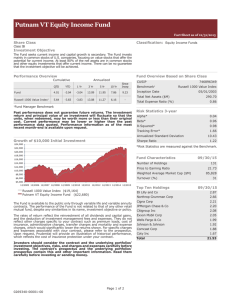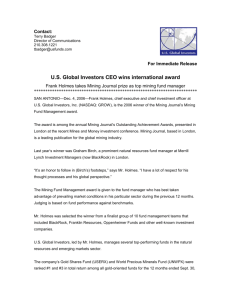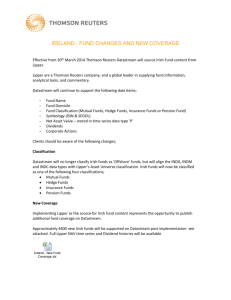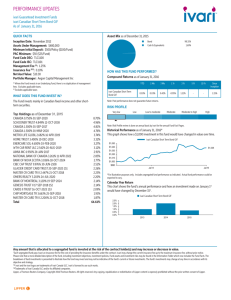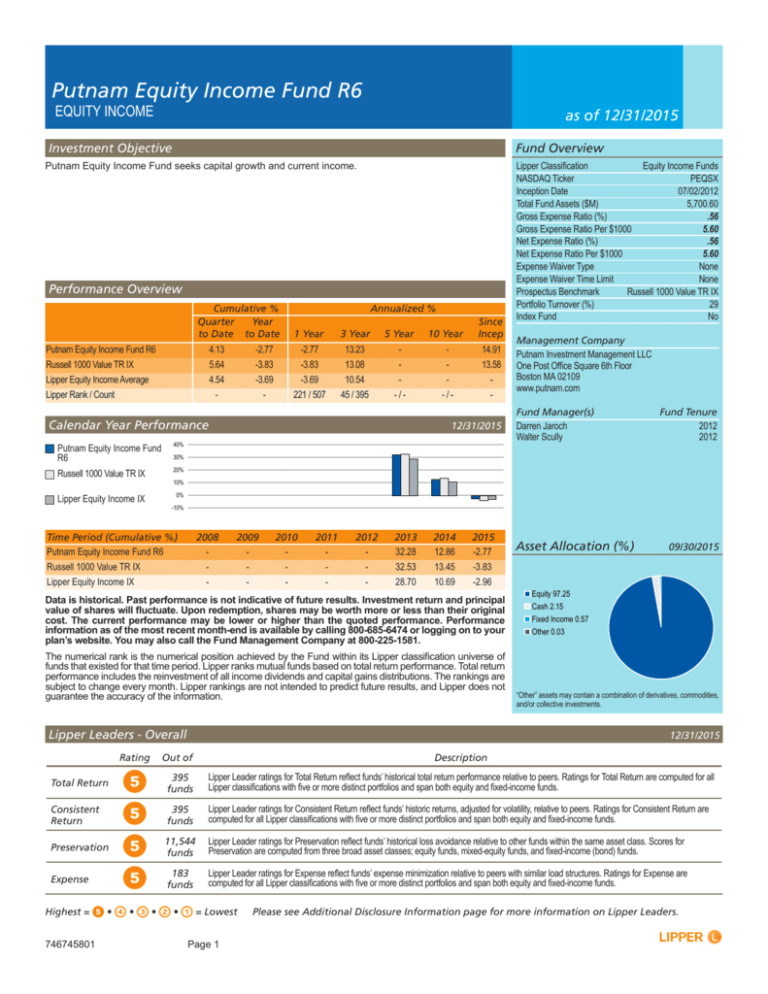
Putnam Equity Income Fund R6
EQUITY INCOME
as of 12/31/2015
Investment Objective
Fund Overview
Putnam Equity Income Fund seeks capital growth and current income.
Performance Overview
Cumulative %
Annualized %
Quarter Year
to Date to Date 1 Year 3 Year 5 Year 10 Year
Putnam Equity Income Fund R6
Russell 1000 Value TR IX
Lipper Equity Income Average
Lipper Rank / Count
4.13
5.64
4.54
-
-2.77
-3.83
-3.69
-
-2.77
-3.83
-3.69
221 / 507
13.23
13.08
10.54
45 / 395
-
-
-
- / -
Calendar Year Performance
Putnam Equity Income Fund
R6
40%
Russell 1000 Value TR IX
20%
Lipper Equity Income IX
-
-
-
- / -
Since
Incep
14.91
13.58
-
12/31/2015
30%
10%
0%
-10%
Time Period (Cumulative %)
Putnam Equity Income Fund R6
Russell 1000 Value TR IX
Lipper Equity Income IX
2008
-
-
-
2009
-
-
-
2010
-
-
-
2011
-
-
-
2012
-
-
-
2013
32.28
32.53
28.70
2014
12.86
13.45
10.69
2015
-2.77
-3.83
-2.96
Data is historical. Past performance is not indicative of future results. Investment return and principal
value of shares will fluctuate. Upon redemption, shares may be worth more or less than their original
cost. The current performance may be lower or higher than the quoted performance. Performance
information as of the most recent month-end is available by calling 800-685-6474 or logging on to your
plan’s website. You may also call the Fund Management Company at 800-225-1581.
The numerical rank is the numerical position achieved by the Fund within its Lipper classification universe of
funds that existed for that time period. Lipper ranks mutual funds based on total return performance. Total return
performance includes the reinvestment of all income dividends and capital gains distributions. The rankings are
subject to change every month. Lipper rankings are not intended to predict future results, and Lipper does not
guarantee the accuracy of the information.
Lipper Leaders - Overall
Total Return
Consistent
Return
Preservation
Expense
Management Company
Putnam Investment Management LLC
One Post Office Square 6th Floor
Boston MA 02109
www.putnam.com
Fund Manager(s)
Darren Jaroch
Walter Scully
Asset Allocation (%)
Fund Tenure
2012
2012
09/30/2015
Equity 97.25
Cash 2.15
Fixed Income 0.57
Other 0.03
“Other” assets may contain a combination of derivatives, commodities,
and/or collective investments.
12/31/2015
Rating
Out of
Description
5
5
5
5
395
funds
Lipper Leader ratings for Total Return reflect funds’ historical total return performance relative to peers. Ratings for Total Return are computed for all
Lipper classifications with five or more distinct portfolios and span both equity and fixed-income funds.
395
funds
Lipper Leader ratings for Consistent Return reflect funds’ historic returns, adjusted for volatility, relative to peers. Ratings for Consistent Return are
computed for all Lipper classifications with five or more distinct portfolios and span both equity and fixed-income funds.
11,544
funds
Lipper Leader ratings for Preservation reflect funds’ historical loss avoidance relative to other funds within the same asset class. Scores for
Preservation are computed from three broad asset classes; equity funds, mixed-equity funds, and fixed-income (bond) funds.
183
funds
Lipper Leader ratings for Expense reflect funds’ expense minimization relative to peers with similar load structures. Ratings for Expense are
computed for all Lipper classifications with five or more distinct portfolios and span both equity and fixed-income funds.
Highest = 5 • 4 • 3 • 2 • 1 = Lowest
746745801
Lipper Classification
Equity Income Funds
NASDAQ Ticker
PEQSX
Inception Date
07/02/2012
Total Fund Assets ($M)
5,700.60
Gross Expense Ratio (%)
.56
Gross Expense Ratio Per $1000
5.60
Net Expense Ratio (%)
.56
Net Expense Ratio Per $1000
5.60
Expense Waiver Type
None
Expense Waiver Time Limit
None
Prospectus Benchmark
Russell 1000 Value TR IX
Portfolio Turnover (%)
29
Index Fund
No
Page 1
Please see Additional Disclosure Information page for more information on Lipper Leaders.
Putnam Equity Income Fund R6
Top Holdings
09/30/2015
Holding Name
% TNA
Top Sector Allocation1
Industry Name
09/30/2015
% TNA
Eli Lilly and Co ORD
2.87
Financials
21.78
Northrop Grumman Corp ORD
2.65
Industrials
11.78
Cigna Corp ORD
2.21
Health Care
11.13
JPMorgan Chase & Co ORD
2.20
Consumer Services
9.85
Citigroup Inc ORD
2.07
Consumer Goods
9.12
Exxon Mobil Corp ORD
2.04
Technology
9.00
Wells Fargo & Co ORD
1.98
Oil & Gas
8.91
Johnson & Johnson ORD
1.91
Utilities
5.03
Comcast Corp ORD
1.88
Non Classified Equity
4.76
Coty Inc ORD
1.67
Telecommunications
3.37
Total
21.48
1
Sector weightings are based on ICB Industries.
Top Country Allocation
09/30/2015
Country
United States
United Kingdom
Ireland
Netherlands
Bermuda
France
Other
Luxembourg
Fund Characteristics
% TNA
89.71
4.21
2.22
2.14
0.74
0.65
0.31
0.03
09/30/2015
Number of Holdings
Avg Weighted Market Cap ($M)
Price to Earnings Ratio
Price to Book Ratio
Return on Equity (%)
130
85822.7
21.73
3.65
18.18
Risk Statistics - 3 Year
Fund
Benchmark
Definition
Standard Deviation
10.35
10.68
Standard deviation is a measure of risk that gauges the variability of actual returns from the expected values and the
dispersion of these variations over time.
Sharpe Ratio
1.24
1.19
Sharpe ratio is a measure that uses standard deviation and excess return to determine reward per unit of risk. The greater a
portfolio’s Sharpe ratio, the better its risk-adjusted performance has been.
Alpha*
0.06
0.00
Alpha measures a manager’s contribution to performance due to security selection or market timing relative to the index. A
positive alpha of 1.0 means the fund has outperformed its benchmark index by 1%. Correspondingly, a similar negative alpha
would indicate an underperformance of 1%.
Beta*
0.96
1.00
Beta is a measure of the volatility, or systematic risk, of a security or a portfolio in comparison to the market as a whole. A
beta of 1 indicates that the security’s price will move with the market. A beta of less than 1 means that the security will be less
volatile than the market. A beta of greater than 1 indicates that the security’s price will be more volatile than the market.
R-Squared*
0.98
1.00
R-squared values range from 0 to 1. An R-squared of 1 means that all movements of a security are completely explained by
movements in the index. A low R-squared means you should ignore the beta.
*Statistics are measured against the Fund’s prospectus benchmark.
Before investing, consider the investment options’ or funds’ investment objectives, risks, charges, and expenses. Call 1-800685-6474 or log on to your plan’s website for an offering statement or prospectus and, if available, a summary prospectus
containing this and other information. Read it carefully.
746745801
Page 2
Putnam Equity Income Fund R6
Additional Disclosure Information
Lipper Leaders Overall
This fund (in Lipper’s Equity Income Funds classification) received the following ratings for the 3-, 5-, and 10-year periods, respectively (number of funds rated follows
the rating in parentheses). Total Return: 5 (395 funds), - (- funds), and - (- funds). Consistent Return: 5 (395 funds), - (- funds), and - (- funds). Preservation (in Equity
Funds asset class): 5 (11,544 funds), - (- funds), and - (- funds). Expense: 5 (183 funds), - (- funds), and - (- funds). Lipper ratings are not intended to predict future
results, and Lipper does not guarantee the accuracy of this information. See Disclaimer Page for additional information. Lipper Leaders ratings DO NOT take into
account the effects of sales charges. The Lipper ratings are subject to change every month and are based on an equal-weighted average of percentile ranks for the
Total Return, Consistent Return, Preservation, and Expense metrics over three-, five-, and ten-year periods (if applicable). The highest 20% of funds in each peer group
are named Lipper Leaders or a 5, the next 20% receive a rating of 4, the middle 20% receive a rating of 3, the next 20% receive a rating of 2, and the lowest 20% receive
a rating of 1. For more information on Lipper Leaders, go to www.lipperweb.com.
Expense Information
The Gross Expense Ratio is the fund’s total operating expenses taken from the most recent prospectus. This ratio excludes waivers and/or expense reimbursements
the Fund Manager might apply. The Net Expense Ratio, also taken from the most recent prospectus, represents the expenses paid with inclusion of waivers and/or
expense reimbursements. When waivers and/or expense reimbursements are included, the Fund’s expenses will be lowered and performance will be higher for the
disclosed expense waiver period. Waiver and/or expense reimbursements can be voluntary or mandated by contract, and can expire either at a specific date, at will, or
indefinitely. Funds Closed to New Investors are not required to file a prospectus, thus the prospectus gross and net expense ratios may not be available. In the event
that the prospectus expense information is not available the expense ratio reported on the latest audited annual report will be provided.
Fees and expenses are only one of many factors to consider when you decide to invest in an option. You may also want to think about whether an investment in a
particular option, along with your other investments, will help you achieve your financial goals.
Fees and expenses for each investment option include the total annual operating expense (annual gross expense ratio), which reduces the investment’s rate of return,
along with any associated shareholder-type fees. The cumulative effect of fees and expenses can substantially reduce the growth of your retirement savings. Visit the
Department of Labor’s website at www.dol.gov/ebsa/publications/401k_employee .html for an example showing the long-term effect of fees and expenses.
Average Weighted Market Cap:
Measures the average market capitalization of all holdings in a fund with each company weighted according to its percent held in the fund.
Price to Earnings Ratio (P/E):
A measure of a company’s valuation that is calculated by dividing the current market price of a stock by the earnings per share.
Price to Book Ratio (P/B):
A measure of a company’s valuation that is calculated by dividing the current market price of a stock by the latest quarter’s book value per share.
Return on Equity (ROE):
A measure of a company’s profitability. ROE represents the average return on equity of the securities in the portfolio.
Portfolio Turnover
A fund pays transaction costs, such as commissions, when it buys and sells securities (or “turns over” its portfolio). A higher portfolio turnover rate may indicate higher
transaction costs and may result in higher taxes when Fund shares are held in a taxable account. These transaction costs, which are not reflected in annual Fund
operating expenses or in the example, affect the fund’s performance.
Top Holdings, Asset Allocation, and Sector Weightings
Data is based on information collected from the investment company, is updated as of the date shown in the section’s title, and will vary over time. Asset Allocation may
equal less than or greater than 100% due to hedged funds or leveraged cash positions by the fund.
Lipper Index
Measures the unweighted average total return performance of either the ten or thirty largest share classes (as available) of funds for a Lipper Classification. The full list
of Lipper Index components is available directly from Lipper. Lipper Indices are unmanaged. It is not possible to invest in a Lipper Index.
Lipper Average
Measures the simple arithmetic average across all funds within the fund’s Lipper classificatoin. Lipper averages are unmanaged. It is not possible to invest in a Lipper
Average.
Prospectus Benchmark
An index assigned to the Fund by the portfolio’s manager to show how the Fund’s total return compares with those of an index measure of market performance. It is
not possible to invest in an index.
The Russell 1000 Value Index is created to measure the performance of the large-cap value segment of the U.S. equity universe. Companies included in this index
generally have low price-to-book ratios and low expected growth values. To ensure that new and growing equities are captured and that the represented companies
continue to reflect value characteristics, the Index is comprehensively reconstituted annually. An investor cannot invest directly in an index.
Lipper, a Thomson Reuters Company. Copyright 2016 Thomson Reuters. All rights reserved. Any copying, republication or redistribution of Lipper content is expressly
prohibited without the prior written consent of Lipper. Lipper Fund Fact Sheets Service.
746745801
Page 3
Putnam Equity Income Fund R6
Supplemental Information
Principal Investment Strategies
We invest mainly in common stocks of midsize and large U.S. companies, with a focus on value stocks that offer the potential for capital growth, current income,
or both. Value stocks are issued by companies that we believe are currently undervalued by the market. If we are correct and other investors ultimately recognize
the value of the company, the price of its stock may rise. We may consider, among other factors, a company’s valuation, financial strength, growth potential,
competitive position in its industry, projected future earnings, cash flows and dividends when deciding whether to buy or sell investments.
Principal Investment Risk
It is important to understand that you can lose money by investing in the fund.
The value of stocks in the fund’s portfolio may fall or fail to rise over extended periods of time for a variety of reasons, including both general financial market
conditions and factors related to a specific company or industry. Value stocks may fail to rebound, and the market may not favor value-style investing. Income
provided by the fund may be reduced by changes in the dividend policies of, and the capital resources available at, the companies in which the fund invests.
The fund may not achieve its goal, and it is not intended to be a complete investment program. An investment in the fund is not insured or guaranteed by the
Federal Deposit Insurance Corporation or any other government agency.
746745801
Page 4


